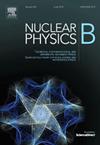Research on high-frequency quasi-periodic oscillations in black bounce-type spacetime
IF 2.5
3区 物理与天体物理
Q2 PHYSICS, PARTICLES & FIELDS
引用次数: 0
Abstract
This paper investigates the high frequency quasi-periodic oscillations (HFQPOs) phenomenon around the black bounce-type (BBT) spacetime using the resonance models. We calculated the location of the innermost stable circular orbit (ISCO) for different types of celestial bodies, and derived the expression for the epicyclic frequencies of test particles. The results show that the BBT spacetime possesses unique observational characteristics, where the ordering of epicyclic frequencies varies with the regularization parameter a, enabling the excitation of low-order resonances and producing stronger observational signals. Using parametric and forced resonance models, we compared theoretical results with the observed 3:2 twin-peak HFQPOs in microquasars (GRO 1655-40, XTE 1550-564, GRS ), analyzed the formation mechanisms of HFQPOs, constrained the parameters of the BBT model, and explored the possible types of celestial objects corresponding to microquasars. The study indicates that, certain parametric resonance conditions (e.g., ) lead to traversable wormhole models in BBT that closely align with observations. And forced resonance corresponding to BH or wormhole models can be verified through observations. These results deviate from the data fits of the original black-bounce model. It is found that the oscillatory behavior of three types of microquasars can also be explained by particle oscillations generated in BBT theory, providing evidence for exploring the existence of wormholes, under the assumptions of parametric resonance and forced resonance.
求助全文
约1分钟内获得全文
求助全文
来源期刊

Nuclear Physics B
物理-物理:粒子与场物理
CiteScore
5.50
自引率
7.10%
发文量
302
审稿时长
1 months
期刊介绍:
Nuclear Physics B focuses on the domain of high energy physics, quantum field theory, statistical systems, and mathematical physics, and includes four main sections: high energy physics - phenomenology, high energy physics - theory, high energy physics - experiment, and quantum field theory, statistical systems, and mathematical physics. The emphasis is on original research papers (Frontiers Articles or Full Length Articles), but Review Articles are also welcome.
 求助内容:
求助内容: 应助结果提醒方式:
应助结果提醒方式:


